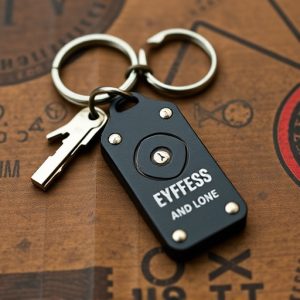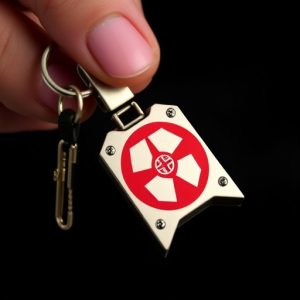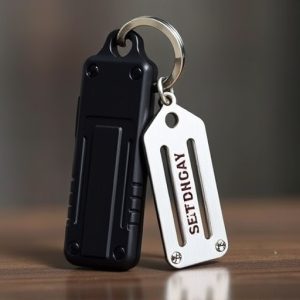Mastering Keychain Weapon Concealment: Design, Legalities, and Materials
The legality of self-defense keychain tools varies globally, with specific regulations on blade leng…….
The legality of self-defense keychain tools varies globally, with specific regulations on blade length and type of weapon allowed. To comply, users should research local laws and choose authorized, non-lethal devices. Designing these tools involves balancing discreetness, ease of use, and materials like stainless steel for strength and weatherproof features. The ideal pocket clip offers secure attachment, swift access, and compact design, while advanced manufacturing techniques create durable, functional tools.
Uncover the world of permitted self-defense keychain tools and explore innovative pocket clip designs that transform everyday accessories into powerful concealment options. This comprehensive guide delves into the legal aspects of carrying keychain weapons, offering insights on navigating restrictions. We examine design considerations for discreet weapon retention, highlighting key features essential for self-defense. Additionally, discover the impact of material choices and construction techniques on durability, ensuring your keychain tool stands the test of time.
- Understanding Legal Permits and Restrictions for Keychain Weapons
- Design Considerations for Effective and Discreet Weapon Concealment
- Key Features of a Successful Pocket Clip for Self-Defense Tools
- Exploring Different Materials and Construction Techniques for Durability
Understanding Legal Permits and Restrictions for Keychain Weapons
In many regions, the possession and carriage of self-defense tools like keychain weapons are governed by strict legal permits and restrictions. It’s crucial to understand these regulations to ensure compliance and promote safety. The legality of such devices varies widely across countries and even within states or provinces, depending on local ordinances.
Permitted self-defense keychain tools typically include specific types of compact, non-lethal weapons designed for personal safety. These may be subject to registration, licensing, or other legal requirements. It’s essential to research and understand the applicable laws in your area to determine what constitutes an authorized self-defense keychain tool. This knowledge will help you make informed decisions about choosing and carrying such devices responsibly.
Design Considerations for Effective and Discreet Weapon Concealment
When designing a keychain weapon concealment pocket clip, the primary goal is to create a seamless and discreet carrying solution for permitted self-defense tools. The key considerations revolve around balance, comfort, and subtle design elements that merge seamlessly with everyday carry items. The clip should securely hold the weapon or tool in place while allowing easy access during emergencies. This requires precise engineering to ensure the keychain doesn’t protrude excessively, avoiding unwanted attention.
Moreover, material choice is crucial for effective and discreet concealment. Opting for materials like high-quality stainless steel or durable yet lightweight aluminum ensures both strength and a low-profile appearance. A well-designed clip should also consider different hand sizes and gripping styles to offer a comfortable and secure fit, enhancing user confidence in their ability to access the weapon when needed.
Key Features of a Successful Pocket Clip for Self-Defense Tools
A successful pocket clip for self-defense keychain tools must prioritize functionality and discreetness. The primary feature is a sturdy and reliable attachment mechanism that secures the tool firmly, ensuring it doesn’t slip or fall out when needed. Look for designs that allow for easy access—a smooth, swift motion to draw the tool should be the goal. Additionally, consider factors like material quality, ensuring it’s durable enough to withstand regular use. The best clips offer a balance between being small and compact, fitting comfortably in your pocket, and providing ample space for the keychain tool to function properly.
Compliance with permitted self-defense keychain tools regulations is crucial. Designs should adhere to legal limits on blade length and overall size, ensuring it remains a practical yet legal defense option. Some clips incorporate additional features like ambidextrous designs, allowing users of different hand dominance to access the tool effortlessly. Moreover, weatherproof or corrosion-resistant materials can enhance longevity and reliability, making them suitable for all environments.
Exploring Different Materials and Construction Techniques for Durability
When designing a keychain weapon concealment with a pocket clip, material selection and construction techniques are paramount for durability. High-quality metals like stainless steel or titanium offer superior strength and resistance to corrosion, making them ideal choices for permitted self-defense keychain tools. These materials can withstand everyday wear and tear while maintaining their structural integrity.
Advanced manufacturing processes such as precision machining and 3D printing enable the creation of intricate designs that boost both functionality and aesthetics. Proper joint design, including robust fastening mechanisms, ensures the clip securely attaches to keys without compromising reliability. Such attention to detail not only enhances the overall usability but also guarantees the keychain weapon concealment pocket clip remains a dependable companion for those seeking permitted self-defense options on the go.
When it comes to keychain weapon concealment, understanding legal permits and restrictions is just the first step. By considering discreet design elements, focusing on key features like durable pocket clips, and selecting robust materials, you can create permitted self-defense keychain tools that offer peace of mind without sacrificing convenience. Remember, the right combination of functionality and discretion can transform a small accessory into a powerful personal safety measure.


